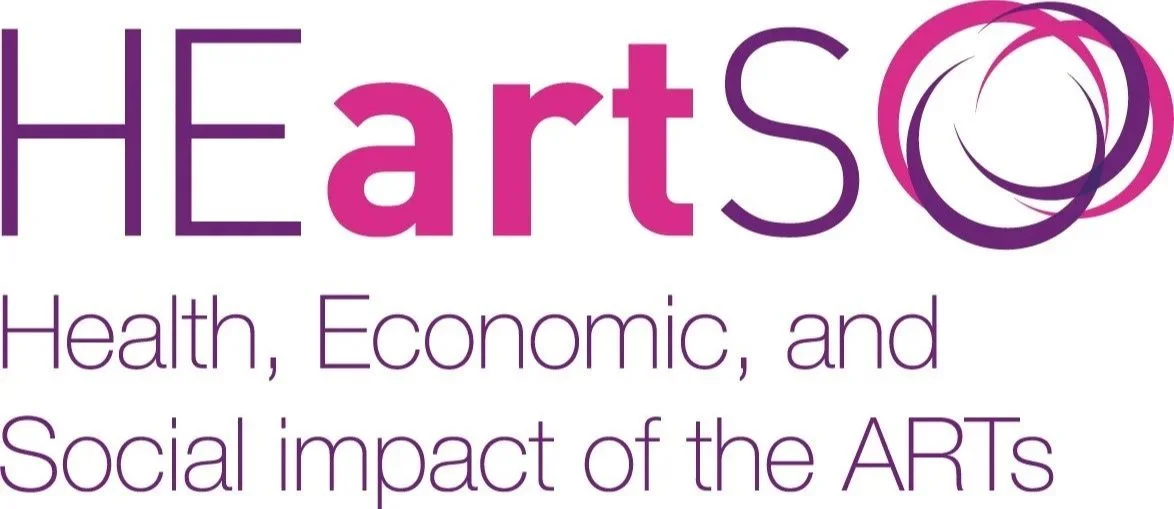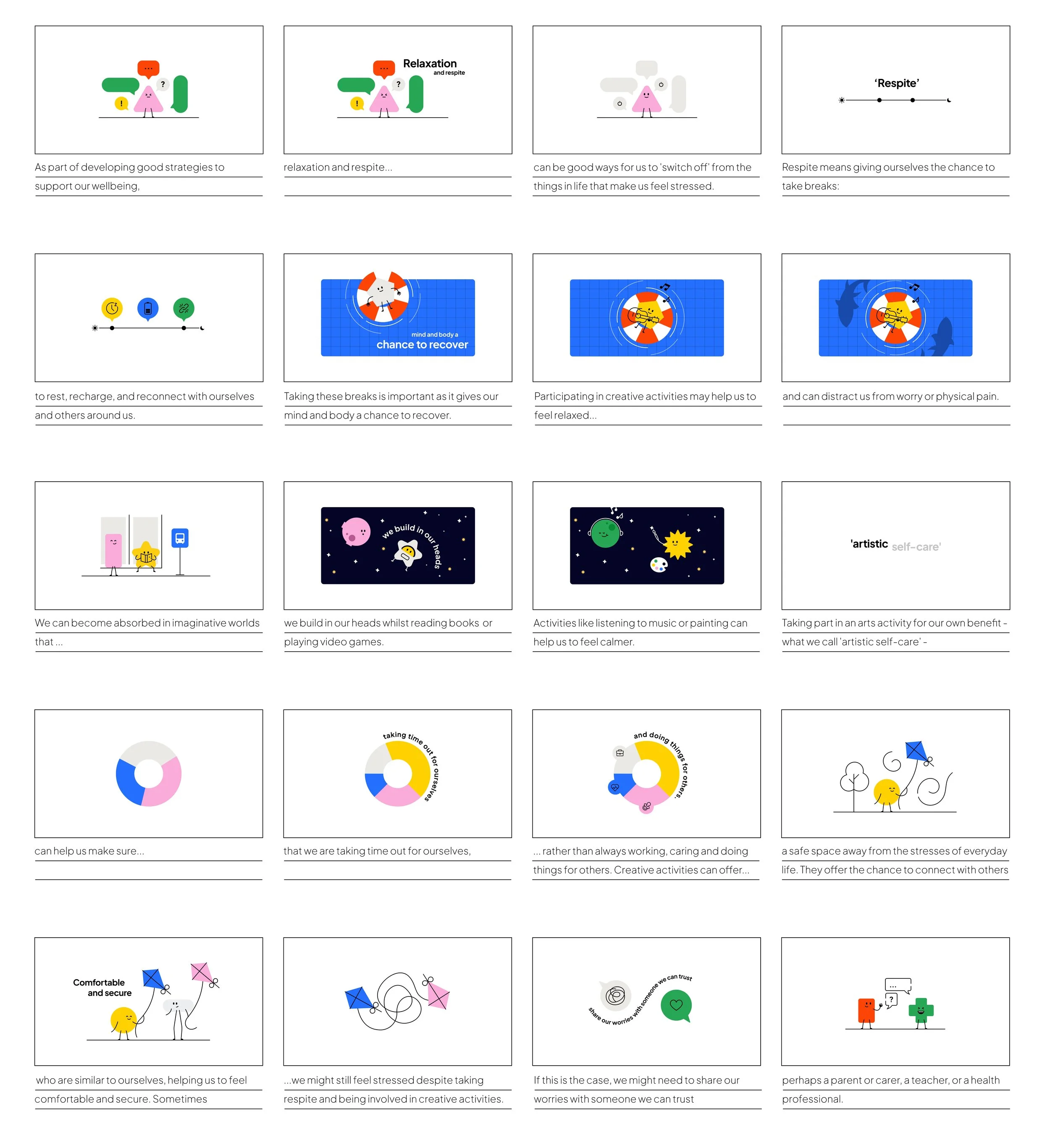
Case Study - Animation
A series of 90-second animations to communicate the research and findings of the HEartS research project, an exploration of how arts and culture impact health and wellbeing

The Project
We were commissioned by the Centre for Performance Science at the Royal College of Music to create a series of audiovisual materials and educational resources that highlight key findings from their HEartS research project. The HEartS project explores how arts and culture impact health and wellbeing across individual, social, and economic levels.
Spanning several months, this project provided us with the opportunity to utilise a wide range of creative and production skills. Working closely with a team of experts, we developed engaging content that made complex research accessible and meaningful to a broad audience - from academics and policymakers to children.
Part of this work involved producing a four-part animated series designed specifically for Key Stage 2 (KS2) learners. The goal was to communicate the research findings clearly and in a way that was age-appropriate, fun, and engaging.
The HEartS Project
The HEartS project - a joint venture between the Royal College of Music and Imperial College London - was funded by the Arts and Humanities Research Council (AHRC) and set out to explore how arts and culture affect our health, happiness, and everyday lives.
Over three years, the team looked at large public health datasets, carried out nationwide surveys, and spoke to people directly about their experiences - from tackling loneliness in older adults to understanding what stops people getting involved in the arts.
They also dug into the value creative activities bring, both socially and economically, and worked with partners across the UK to share findings.
The result was a rich, detailed picture of how music, theatre, galleries, and other cultural activities can make a real difference to society and individual health and wellbeing.
We also worked on the production of a podcast series to communicate the HEartS report findings, read about this here.
Our Approach
We worked collaboratively with the client from day one, shaping the content so it was clear, engaging, and perfectly suited to the KS2 audience. Starting with a strong script, we built the visuals, animation, and sound step by step, checking in regularly to make sure everything felt right.
The whole process was creative, collaborative, and focused on bringing the client’s vision to life in a way that really connected with the audience.
Script Development
We developed the scripts in close collaboration with the research team, making sure the academic content was translated into language that would resonate with younger viewers - it was key to keep the script clear and relatable, while also delivering the most important research findings.
Getting the script right was crucial before moving on to illustration and animation. Because the visuals needed to support and enhance the story, we made sure the script was solid in tone, pacing, and message. For a KS2 audience especially, every word was carefully chosen to balance clarity and sensitivity, while ensuring it was age-appropriate.
A strong script formed the foundation for all the creative choices that followed. It shaped the visual style, character design, scene flow, and animation rhythm.
Storyboard and Style Frames
Once the scripts had been approved, we were in a better position to start thinking about how some of the visual aspects of the animation might come together.
We knew we wanted to create animated figures that were relatable and simple enough to convey the messages effectively. Matt and Nicole from ink helped to bring our vision to life in the form of these colourful shapes. At this point, we also thought carefully about how these figures may act and relate to one another to support the narrative and help convey the messages.
Illustration
The illustrations were designed to be warm, inclusive, and emotionally engaging. Using a hand-drawn, textured style with a bright, cheerful colour palette, the visuals are both appealing and age-appropriate.
The characters were simple but expressive - and undeniably cute! The intention was that this would help children to relate to a range of emotions and situations without feeling overwhelmed. The settings were kept minimal but familiar, focusing attention on the characters and the story.
This illustration style also helped to gently handle sensitive topics, making them easier for children to engage with. Overall, the visuals worked hand-in-hand with the voiceover and script to create an accessible, cohesive, and emotionally resonant experience.













Voiceover
The voiceover was fundamental in bringing the animations to life. We used a warm, friendly, and relatable voice that could clearly communicate the script while conveying empathy and authenticity.
This was particularly important to us given the wellbeing themes. The delivery was designed to feel like a conversation, making young viewers feel engaged and the material easy to understand. The pacing was adjusted to give space for the visuals and key messages to sink in.
Motion Design
Once again, we worked closely with Matt and Nicole from ink to bring our characters to life.
Given the young audience and the sensitive nature of the subject, the animation focused on subtle, expressive movement rather than fast action. This allowed the emotions and ideas to unfold naturally, supporting understanding and emotional connection.
Transitions between scenes were smooth and calm, guiding viewers gently through the stories. Character animations featured small, relatable gestures - like changes in posture or facial expressions - to communicate feelings clearly.
We also paid close attention to timing and rhythm, ensuring the animation complemented the voiceover and gave space for key messages to land.
We were in regular contact with the research team throughout this process to ensure that the animations were aligned with the client’s vision. This helped to avoid any big surprises or amends at the end of production.
Music and Sound Design
We then brought in Eddie Dobson from Fine Line Audio to take the lead on sound design. Soft ambient sounds and gentle effects were added thoughtfully to enhance key moments and bring scenes to life without distracting from the voiceover. These audio elements immerse young viewers in the stories, adding depth and interest while keeping things clear and easy to follow.
Together, the music and sound design guide the emotional journey, making the content both engaging and memorable.
The music and sound design were created to support the animation’s gentle, reflective mood and the themes of health, wellbeing, and cultural engagement. Tailored for KS2 children, the soundtrack features simple, soothing melodies with subtle instrumentation, creating a calm and welcoming atmosphere.
Final Editing and Subtitles
Adobe Premiere was used to bring all of the parts together, including the rendered animations, music, voiceover and sound design. Premiere allows us to do one final check to make sure all parts are working in harmony. This stage also provides a good opportunity to make any last-minute tweaks.
There is an additional opportunity during this phase to produce the subtitles for the animation. Typically, clients will request versions both with and without subtitles with an accompanying .srt file for when videos are being uploaded to YouTube or social media.
Once that stage is complete, all that’s left is for us to send the final versions over to the client, making any final small tweaks if required. We usually find there aren’t too many amendments at this stage, we believe this is a direct result of our clear communication and regular updates throughout the entire process.
In Summary
The animations were very well received by the client and audience alike. The Centre for Performance Science were pleased with how we transformed detailed research into something fun and accessible for kids. Teachers and viewers gave positive feedback, praising the animation’s clear messaging, warm tone, and friendly characters.
Overall, the response showed the project hit the mark - educating and inspiring young audiences in a way that truly connected with them.
Interested to learn more about the HEartS project? You can read about the podcast series we produced for the Centre for Performance Science here.
You may also like:
The Animation Process
We’ll take you through the entire process of creating an animation that will capture your viewer’s attention.
Case Study
Podcast
The Performance Science podcast
Portfolio
Animation
HEartS Animation - Arts for Managing and Expressing Emotion







